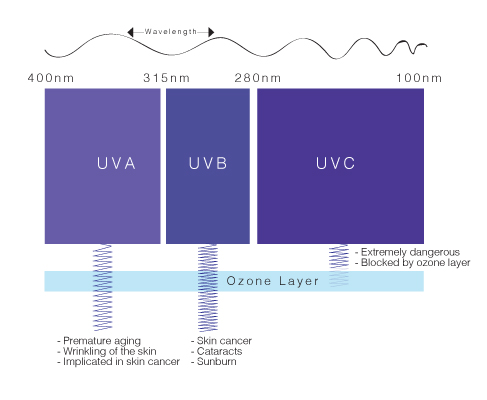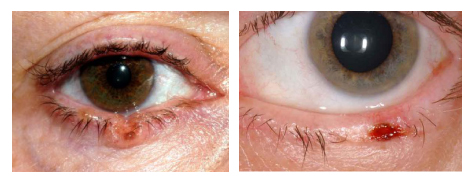The Dangers of Ultraviolet Radiation to the Eye
Article by: Cheryl Kee | Alexis Paragon & Ngee Ann City
Electromagnetic radiation is a form of energy, most of which is invisible to the human eye. Ultraviolet ray (UV) is an invisible form of electromagnetic radiation that lies beyond the violet/ blue end of the visible spectrum.

Sunlight is the greatest source of UV, while other sources include tanning booths, mercury vapour lighting (often in stadiums), as well as certain halogen, fluourescent, and incandescent lightings.
Ultraviolet radiation is classified into 3 types:
- UVA - causes tanning but is also thought to contribute to cellular aging and skin cancer
- UVB - shorter wavelength than UVA, hence higher in energy and more damaging to cellular tissues
- UVC - most damaging to the health, but fortunately, they don't get through our atmosphere due to the ozone level
Types of Ultraviolet Radiation

UVA and UVB rays can cause damage to your skin. Sunburn is an effect of temporary overexposure to UV, while premature aging and skin cancer are prolonged side effects. However, do you know that UV can also cause damage to the eye? More than 99% of UV radiation is absorbed by the front structures of the eye!
So what is the impact of UV on the eye?
Most people have a misconception that they are only exposed to UV when they are outdoors on a sunny day. However, this is not true. UV light can penetrate the clouds, and you are also exposed to UV even if the sky is overcast. UV leads to premature degeneration of the eye structures, predisposing the individual to various eye conditions.
Examples of eye conditions (WARNING: the following include images that might cause discomfort to the reader):
- Pinguecula and Pterygium
Pinguecula and pterygium refer to tissue growth on the white of the eye, where the latter may sometimes extend onto the cornea and block the vision. These are more commonly found in people who work under the sun, and the prevalence is related to the amount and duration of UV exposure. Pterygium can cause cosmetic concerns and visual loss if it is not surgically removed.

Left: Pinguecula | Right: Pterygium
- Cataract
Ultraviolet radiation has been associated with cataract formation and retinal degeneration. Studies have shown that certain types of cataract are associated with a history of higher exposure to UV and especially UV-B radiation. UV causes changes to our natural lens' protein, causing the lens to become cloudy, thereby causing cataract to form. People with cataract will report symptoms such as glare and hazy vision.

Examples of cataracts
- Photokeratitis
Photokeratitis (commonly know as Snow Blindness) is a sunburn of the cornea as a result of excessive UVB exposure, which causes the eye to be inflamed. This incidence of photokeratitis is higher in those with occupational or recreational exposure to UV such as welder and skiers without proper eye protection.Those with photokeratitis will report having painful eyes that last for a few days, and sometimes temporary loss of vision. Fortunately, this condition is usually reversible and resolves without long term consequences on the vision.

Example of Photokeratitis
- Macular Degeneration
Although the cornea and the natural lens block a major portion of UV from reaching the retina, UV can also cause damage to the back part of the eye - the retina and macular, leading to earlier onset of macular degeneration. This can impair the central vision as well as color vision perception.

Macular Degeneration and the effect on vision
- Eyelid Tumours
Since your eyelid skin contains less pigment than facial skin, it is especially sensitive to the disruptive energy of ultraviolet radiation. Solar radiation, especially UVB exposure is crucial in the development of malignant eyelid tumours such as basal cell carcinoma, squamous cell carcinoma and melanoma.

Examples of eyelid tumours
Do Children need to protect their eyes from the sun?
Many parents are unaware that children also need UV protective eyewear when they are out in the Sun. The risk of damage to our eyes from solar UV radiation is cumulative throughout our lifetime. Therefore, it is essential for kids to protect their eyes from the sun, especially since they spend longer time outdoors than adults. Furthermore, children are more susceptible to retinal damage from UV rays as they have larger pupils and their natural lens are clearer, thus enabling more UV to penetrate deep into the eye and cause early damage to the eye structures.
How can we protect our eyes from the harmful effects of UV?
Protection from sunlight can be obtained by using a brimmed hat and a pair of sunglasses. A wide-brimmed hat can only block approximately half the amount of UV radiation. On the other hand, sunglasses provide the greatest measure of UV protection. When selecting a pair of sunglasses, it is important to choose one that is labelled 'UV400', as this can block 99 to 100% UVA and UVB. You may also consider having a wraparound design as this can limit the entry of UV rays from the periphery.
So, the next time you head out, remember to bring along your sunnies! It not only serves as a fashion statement, it also protects your eyes and vision!
References:
Case Study of the Week: Photokeratitis | MidlevelU. (n.d.). Retrieved from https://www.midlevelu.com/blog/case-study-week-photokeratitis
The Dangers Of UV Radiation To Your Eyes. (n.d.). Retrieved from https://www.allaboutvision.com/sunglasses/spf.htm
The Dangers Of UV Radiation To Your Eyes. (n.d.). Retrieved from https://www.allaboutvision.com/sunglasses/spf.htm
The known health effects of UV. (n.d.). Retrieved from https://www.who.int/uv/faq/uvhealtfac/en/index1.html
Ultraviolet (UV) Radiation. (2017, December 12). Retrieved from https://www.fda.gov/radiation-emittingproducts/radiationemittingproductsandprocedures/tanning/ucm116425.htm
Pinguecula. (2016). Retrieved from https://aneskey.com/pinguecula-and-pterygium/
Pterygium. (n.d.). Retrieved from https://www.indiamart.com/proddetail/pterygium-and-pinguecula-9229629888.html
